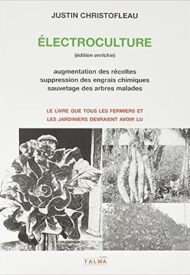Greetings and welcome to Electroculture Magazine, eco-revolutionaries! We are excited to take you along on a journey of scientific innovation and environmentally friendly farming methods. In our main article today, “How to Design an Antenna for Electroculture,” we reveal the techniques for creating antennas specifically for the intriguing field of electroculture.
We at Electroculture Magazine are committed to investigating how science and agriculture may coexist peacefully. Our goal is to arm you with information and ideas that will change the way we manage the resources on our planet.
This essay will take you deep inside the complex craft of making antennas created particularly to harness the power of electromagnetic in agriculture. We’ve put up a thorough guide to highlight this fascinating topic, covering everything from comprehending the fundamental concepts to choosing the best materials and doing real-world experiments.
But this is only the start. Your compass on the path to sustainable and creative farming is Electroculture Magazine. Watch this space for more engrossing articles, knowledgeable interviews, and discoveries that enlighten the way to a more successful, environmentally friendly future.
Join our group of futurists, scientists, and eco-warriors as we harness the power of electromagnetism to create a future that is brighter and more sustainable. Welcome to Electroculture Magazine and to a new age in agriculture!
Criteria : Design for an Antenna for Electroculture
Designing an antenna for electroculture, a niche field combining agriculture and electromagnetism, requires careful consideration of various criteria to ensure its effectiveness in promoting plant growth. Here are key design criteria to keep in mind:
1. Frequency Selection:
The choice of frequency is crucial when developing an antenna for electroculture. Your antenna’s ability to promote plant growth can be considerably influenced by the frequency at which it operates. According to research, some frequencies have a more significant effect on a plant’s health than others.
Especially for electroculture applications, the extremely low-frequency (ELF) range, which covers 1 Hz to 300 Hz, has shown promise. Studies have shown that electromagnetic fields in this frequency range may improve agricultural productivity by promoting root growth and plant growth.
It’s crucial to match your frequency selection with your unique electroculture objectives while creating your antenna for electroculture. Think about the kinds of plants you want to grow, the developmental phases they will go through, and any unique environmental factors that could affect your choice. The antenna’s capacity to harness electromagnetic and encourage strong, healthy plant development will be optimised by tailoring the frequency range to your specific needs. This will eventually help to promote more sustainable and fruitful agricultural practises.
2. Antenna Type:
Choosing the proper antenna variety is essential when designing an antenna for electroculture. Each antenna type, be it a dipole, a loop, or a mono-pole, has a unique radiation pattern that can have a significant influence on its ability to transmit electromagnetic fields to your plants.
Due to their balanced design, dipole antennas emit radiation in two opposing orientations. They are ideal for applications where a uniform distribution of electromagnetic radiation over a large area is desired.
In contrast, loop antennas emit a more concentrated radiation pattern, making them ideal for targeting particular plant plots or rows. Their concentrated field can be advantageous when precise electromagnetic stimulation delivery is required.
Monopole antennas are simple and versatile, radiating in a single direction. Smaller garden installations or situations requiring straightforward, unidirectional coverage may benefit from their use.
The model of antenna you choose should correspond with the specific characteristics of your field or garden and your electroculture objectives. Consider factors such as field shape, plant configuration, and the intended electromagnetic field intensity and distribution. By selecting the correct antenna type, you can maximize the impact of electroculture on plant growth and cultivation practices.
3. Antenna Dimensions:
The size of the antenna elements play a crucial role in the construction of an efficient electroculture antenna. The size of the antenna have a direct impact on its capacity to generate the intended electromagnetic fields that facilitate the stimulation of plant growth. Ensuring the alignment of antenna components with the chosen frequency is of utmost importance in order to get maximum efficiency.
Resonance assumes a critical significance within the realm of electroculture. Resonance is observed when the dimensions of the antenna align with the wavelength of the chosen frequency. When an antenna is operating at its resonance frequency, it exhibits a significantly enhanced capability to efficiently emit electromagnetic energy. The enhanced efficiency results in a heightened and concentrated electromagnetic field, so yielding a more substantial influence on the development of plants.
In order to optimize the performance of the antenna, it is imperative to accurately calculate and meticulously construct the antenna parts. In order to produce resonance, it is necessary for the dimensions to be in alignment with the wavelength of the selected frequency. The careful and thorough consideration of details will enhance the strength and dispersion of the electromagnetic field, hence maximizing its efficacy in facilitating the cultivation of healthy and vigorous plants in electroculture practices.
4. Materials:
The choice of materials is crucial when creating an antenna for electroculture since it has a substantial impact on the antenna’s conductivity and endurance. Making the best material selections is crucial to ensuring that electromagnetic fields are transmitted properly to encourage plant growth.
Due to their high conductivity qualities, copper and aluminium wires are preferred materials for antenna construction. Particularly highly conductible copper is widely used in antenna elements. It enables effective electromagnetic energy transmission, ensuring that the produced fields are delivered to the plants as planned. Although somewhat less conductive than copper, aluminium is still a great option and is frequently chosen because of its low weight and affordable price.
Another good choice is stainless steel, which is well regarded for its resistance to corrosion. In outdoor and agricultural environments where exposure to moisture and the weather is a problem, this is especially helpful. As long as your antenna is made of stainless steel, it will remain structurally sound.
Materials should be chosen with your particular electroculture application in mind, taking conductivity, cost, and environmental circumstances into account. Whether you choose copper, aluminium, stainless steel, or another suitable material, it is essential to making sure your antenna works successfully and efficiently so that your plants may develop more healthily and vibrantly.
Also Refer This Electroculture Tools For Your Experiment,
5. Power Source:
Selecting an appropriate power source for your electroculture antenna is a pivotal decision in the design process. The power source is the heartbeat of your system, supplying the necessary energy to generate the electromagnetic fields that stimulate plant growth.
One option for powering your antenna is a signal generator. This device produces precise and controlled electromagnetic signals at the desired frequency. Signal generators are favored for their accuracy and ability to fine-tune the output to match the specific needs of your electroculture setup. They are ideal when you require consistent and controlled electromagnetic fields to optimize plant growth conditions.
Alternatively, you may choose a battery-powered system. Batteries provide portability and autonomy, making them suitable for remote or off-grid electroculture applications. Battery-powered antennas are often employed in agricultural settings where access to a consistent electrical supply may be limited.
The selection of the power source hinges on your specific electroculture setup, goals, and available resources. Whether you opt for the precision of a signal generator or the versatility of a battery-powered system, the power source is the driving force behind your antenna’s ability to enhance plant growth and contribute to sustainable agriculture practices.
6. Placement and Grounding:
When designing and deploying your system, it is crucial to take your electroculture antenna’s location and grounding into account. The efficiency and security of the antenna are greatly influenced by these variables.

It’s important to choose the right spot in your field or garden. To achieve equal coverage and plant exposure to the produced electromagnetic fields, the location should be carefully chosen. It is necessary to take into consideration variables including the electromagnetic field’s desired strength, plant structure, and field form. It is possible to maximise the antenna’s effect on plant development by making sure it is correctly raised and angled.
Grounding is also crucial. By discharging excess electrical charge into the Earth and reducing the possibility of electrical risks, a properly grounded antenna provides safe operation. Electromagnetic field propagation efficiency is also influenced by grounding. It serves as a reference point for the electrical potential of the antenna, allowing the electromagnetic waves to propagate successfully.
It’s critical to carefully design the location of your antenna inside your agricultural space and to put good grounding procedures in place if you want to practice electroculture successfully. These factors will support healthy plant development and sustainable farming methods, as well as the safety and effectiveness of your electroculture system.
7. Safety Measures:
Safety is paramount when designing an electroculture antenna, especially if your design involves high voltage or currents. Implementing rigorous safety measures is essential to protect both you and the environment. Here are some crucial considerations:
- Electrical Safety: High voltage and current can be hazardous. Ensure that all electrical components of your antenna are properly insulated and grounded to prevent electrical shocks or fires. Use appropriate safety gear when working with high-voltage systems.
- Environmental Impact: Be mindful of the potential environmental impact of your antenna. Electromagnetic fields should be controlled and confined to the target area to prevent unintended consequences on nearby ecosystems.
- Compliance with Regulations: Familiarize yourself with local and national regulations concerning electromagnetic radiation and high-voltage equipment. Ensure that your antenna design and operation comply with these regulations.
- Safety Training: If you are working with a team, provide safety training to all involved individuals. Ensure that everyone understands the risks associated with the antenna and knows how to respond in case of emergencies.
- Emergency Procedures: Develop and communicate clear emergency procedures for dealing with accidents or malfunctions. This includes protocols for shutting down the antenna and seeking medical attention if necessary.
By incorporating safety measures and adhering to regulations, you can mitigate risks associated with high-voltage and electromagnetic field equipment, creating a safer working environment for yourself and those around you while advancing the exciting field of electroculture.
8. Experimentation and Monitoring:
An electroculture antenna’s design is a complex and constantly changing process that usually calls for a trial-and-error method. To get the desired outcomes on this dynamic trip, frequent experimentation and close observation are required.
An essential component of this procedure includes keeping track on plant development. Watch the plants that are being exposed to these stimuli attentively while your antenna creates electromagnetic fields. Track vital statistics including growth rate, general health, and any apparent changes attributable to the electromagnetic stimulation as you meticulously record their progress.
The electrocultural process is centred on experimentation. Accept the dynamic character of this area since it is only through testing that you may find the perfect antenna settings. These variables might consist of frequency, field intensity, exposure time, and the particular requirements of the plants under your care.
Be ready to modify your antenna’s settings as you acquire information and insights from your tests. In electroculture, adaptation is crucial because it enables you to tailor your system to provide the best circumstances for plant development. It’s an ongoing cycle of observation, correction, and improvement.
To maximize the potential of your electroculture antenna, experimenting and monitoring are ultimately the key. Your commitment to these iterative techniques not only results in healthier and more robust plant growth, but it also continues to advance the advancement of effective and sustainable farming practices, establishing your position as a pioneer in this developing sector.
9. Data Collection:
Data collecting is essential in the construction of an electroculture antenna. It provides the factual foundation for evaluating the antenna’s efficacy and making educated adjustments to optimise plant development.

Establish a systematic technique of monitoring plant development and health in order to acquire meaningful data. This procedure requires painstakingly recording observations and measurements at regular intervals. Parameters to consider include growth rate, stem diameter, leaf size, flowering patterns, and overall plant vitality. Take note of any differences or improvements compared to control groups that were not exposed to electromagnetic fields.
Meticulous data collecting yields important insights into the effect of antenna-generated electromagnetic fields on plant biology. These findings will help you understand the antenna’s efficacy and potential to increase crop yields.
Furthermore, the data gathered assists in the refinement of your antenna design and operating settings. You may fine-tune your electroculture system to get best outcomes by associating various field intensities, frequencies, or exposure periods with favourable plant responses.
Remember that the capacity to integrate scientific study with practical application is critical to the success of electroculture. You not only contribute to the developing knowledge base in this sector by collecting and analyzing data diligently, but you also lead the creation of more sustainable and productive farming practices. Your dedication to this procedure establishes you as a trailblazer in the fascinating world of electroculture.
10. Compliance:
Navigating the regulatory landscape is a paramount consideration when designing an electroculture antenna. To ensure the safe and compliant operation of your system, it is crucial to familiarize yourself with any local or national regulations governing electromagnetic field emissions within your region.
Electromagnetic fields have the potential to affect not only plant growth but also the environment and human health. Many regions have established guidelines and limits for electromagnetic radiation to safeguard against potential hazards. These regulations often define permissible field strengths, frequency bands, and emission levels.
Compliance with these regulations is essential for ethical and responsible electroculture practices. Failure to adhere to these standards can result in legal consequences, environmental harm, and potential health risks. It is your responsibility as an electroculture practitioner to ensure that your antenna design and operational parameters fall within the boundaries set by local authorities.
To achieve compliance, collaborate with experts in electromagnetic field safety and engage with regulatory bodies when necessary. This proactive approach not only ensures that your electroculture endeavors are conducted responsibly but also helps build trust within your community and the broader agricultural and scientific communities. By adhering to regulations, you contribute to the development of electroculture as a sustainable and safe agricultural practice.
Conclusion
Finally, the art of developing an electroculture antenna offers an enthralling fusion of agricultural and electromagnetic sciences. It’s a path that necessitates a thorough comprehension of both domains as well as a dedication to practical experimentation motivated by real-world outcomes. The convergence of these disciplines has the potential to revolutionise sustainable agriculture practises and usher in a new age of environmentally friendly farming.
Several critical criteria have emerged during this process. The basic building pieces include frequency selection, antenna type, size, and materials, all of which contribute to the antenna’s efficiency and effectiveness. The selection of an appropriate power source, as well as careful placement within your field or garden, ensures that the generated electromagnetic fields are carefully channelled for optimum impact.
However, it is not only about technical prowess. Safety precautions and regulatory compliance highlight the necessity of appropriate electroculture practises, which protect not only your interests but also the environment and human health.
Experimentation and data collecting are at the heart of electroculture advancement. This iterative method allows for continual refinement, allowing you to maximise the potential of your antenna and harness the power of electromagnetic to grow healthier and more abundant crops.
Finally, developing an electroculture antenna is about more than just increasing plant growth; it’s about ushering in a more sustainable and efficient agricultural future. By following these guidelines and embracing the dynamic nature of electroculture, you may become a champion for ecologically friendly and productive agricultural practices. Your dedication to this cutting-edge field brings us closer to creating greener and more bountiful harvests for future generations.
Also Refer This Electroculture Books For More Guidance,





















